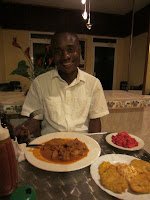 |
| Map of Cayes. |
Saturday
morning Rhoda and I decided to explore a road that we could see on a map, to
see if there was a path from it that went all the way to the ocean.
The road is called Route Wharf Masse, and it
starts just on the other side of the Cayes gate (arch) that is just past our
road to AUC.
The road runs past the agriculture
organization SEED, which Rhoda had been to many times, so she was familiar with
this end of the road.
We started
out around 6:45am, and the walk on this road was very peaceful.
Not many people out on it, and I don’t
remember seeing any motorcycles once we got a ways south from the highway.
The road runs past rice fields which had
green herons and black-necked stilts.
A
canal diverts water from a nearby river into the fields.
 |
| A mangrove tree and corn in the rice fields south of AUC |
 |
| The neighborhood of Islet, where the river meets the sea. |
 |
| Making lobster traps. |
 |
| Me and Martelly. |
 |
| Discussing the fish in the canal |
After the
road took a sharp right west toward town, we came to a ponded area of the canal
in which there were at least 3 species of fish - bon boni with yellow tails, a
fish called teta which is the Kreyol word for tadpole (but Rhoda was sure the
man was using it for a fish) and a fish called kongo (fish post coming later).
The road was getting busier with all the
people carrying their wares to the market.
 |
| Sorting charcoal (notice they are standing on charcoal) |
The road
came out on the main road that runs northwest-southeast through Cayes, Avenue Des
Quatre Chemins. Rather than staying on
this busy road, we went east one road and ended up in an even busier
market. Not for those who don’t like
crowded cultural experiences! The road
was a bit muddy, there were many places where you had to jump over water
streaming across the road, it was VERY crowded with people selling food (raw
meat, veggies, rice, spices, fruit) and clothing (I bought a blouse for 150 gd
($3.75), probably too much but I talked her down from 250 gd). Finally the market ended and we ended up
walking through a narrow little neighborhood called Islet that popped out where
the river meets the ocean. This was
about 4km (2.5mi) from AUC. People were
bathing in the confluence, kids were playing (or bathing?), men were working on
their boats and lobster traps. It was
quite the cultural experience you can’t get from driving. And I learned that “I love you baby” sounds a
lot like “Hello Debbie” (the guy who said it seemed pretty happy that I responded
by shaking his hand).
 |
| Mangroves |
 |
| Sail boat taxi. |
 |
| Carrying the market lady from the sail boat. |
From Islet
we headed west and followed roads that hugged the ocean, detouring down them to
see what was on the coast. We came
across public latrines that a Rotary club had built (and that were in great
need of emptying), a trashy mangrove, a park built by Martelly, a pier where
people were unloading wooden poles and charcoal, and finally a pier where
cement was being unloaded from little wooden boats that brought it in from a
large ship docked out in the bay. Men
were then bagging up the cement for transport into town. There was a cute but trashy park at this
pier, and a nice
salesman from NatCom who welcomed us and said thanks for not
being afraid to visit Cayes (he also knew some Vietnamese, as NatCom is a
Vietnamese cell phone company).

 |
| The ship of cement. Notice the small wood boats along side it. |
 |
| Unloading and packing up cement |
At 10:30am
we ended the trip by catching a moto for the 3.5km (2mi) back campus (2 of us on
the same one!).
It was a great walk, and
if anyone is brave enough to visit me in Haiti, I look forward to taking you walking
to see rural, city, and ocean-side life in Haiti.

 |
| The moto ride home. |
 |
| Fried bread is always good! 5 gds each. |
 |
| Rhoda and the Rotary latrine. |
|
|
|
|
|
|




































